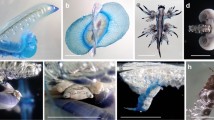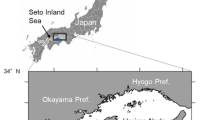Summary
We stayed on the Portugese island of Selvagem Grande, 30° N 16° W, 300 km south of Madeira and 200 km north of Tenerife, from 9 May to 3 June 1991 in order to study the prelaying exodus in Cory's Shearwaters (Calonectris diomedea borealis) and its connection with the colony attendance cycles described earlier. Laying took place on 1.5 June ±3.4 days. During the preceding weeks males and females of Cory's Shearwater show very different attendance patterns. Females are absent for 19±4.8 days at minimum. Absences of males are much shorter and also much more variable. They last 7.9±6.0 days (coefficient of variation 76 %, as against 12 % in females). The first incubation stint of the males is badly synchronised with the laying: the delay between laying and the start of the males' first stint may amount up to one week, without compromising the breeding success. Two well marked attendance peaks have been observed, separated by an interval of 18 days, twice the length of that observed in June 1988. We suggest that this anomaly in the daily attendance graph is correlated with the prelaying exodus. The function of the prelaying exodus and its relation with the energy cost of producing the egg and the necessity of storing lipid reserves are discussed.
Zusammenfassung
Zwischen 9. Mai und 3. Juni 1991 untersuchten wir auf der portugisischen Insel Selvagem Grande, 30° N 16° W, 300 km südlich von Madeira und 200 km nördlich von Teneriffa gelegen, das Verlassen der Kolonie vor der Eiablage des Gelbschnabelsturmtauchers (Calonectris diomedea borealis) und die Beziehung zur Anwesenheit in der Kolonie. Gelegt wurde am 1,5 Juni ±3,4 Tage. In den Monaten vor der Eiablage zeigten Männchen und Weibchen sehr unterschiedliche Muster der Anwesenheit in der Kolonie. Während die Weibchen im Minimum durchschnittlich 19±4,8 Tage abwesend waren, war diese Abwesenheit bei den Männchen mit 7,9±6,0 Tagen wesentlich kürzer und variabler (Variationskoeffizient 76 % gegenüber 12 % bei den Weibchen). Die erste Brutbeteiligung des Männchens war kaum mit der Eiablage synchronisiert, doch war dadurch der Bruterfolg nicht beeinträchtigt. Die Anwesenheit in der Kolonie zeigte zwei Gipfel, die 18 Tage auseinander lagen. In 1988 betrug dieser zeitliche Abstand nur etwa die Hälfte. Es wird vermutet, dass dieser Unterschied mit dem Ausmaß des vorbrutzeitlichen Verlassens der Kolonie korreliert. Die Funktion dieses vorbrutzeitlichen Exodus und seine Beziehung zu den energetischen Kosten der Eiproduktion und der Bildung von Lipidreserven werden diskutiert.
Similar content being viewed by others
References
Despin, B, & Mougin, J.-L. (1988): Evaluation de la dépense énergétique et de la consommation alimentaire du Puffin cendréCalonectris diomedea borealis d'après l'étude de la décroissance pondérale au cours du jeûne. Oiseau Rev. fr. Orn. 58: 28–43.
Fernandez, O. (1985): La reproduction du Puffin cendréCalonectris diomedea dans les îles de Marseille. In: Oiseaux marins nicheurs du Midi et de la Corse: 56–57. Annal. C.R.O.P. 2, Aix-en-Provence.
Gaultier, T. (undated): Contribution à l'étude deCalonectris diomedea diomedea de l'île de Zembra (Tunisie). Inst. rech. sc. techn., section ornithologique, Campus universitaire, Belvédère, Tunis.
Granadeiro, J. P., Burns, M. D. & Furness, R. W. (1998): Patterns of activity and burrow attendance in Cory's ShearwaterCalonectris diomedea as revealed by a novel logging technique. Ibis 140: 458–466.
Imber, M. J. (1976): Breeding biology of the Greyfaced PetrelPterodroma macroptera gouldi. Ibis 118: 51–64.
Jouanin, C., Roux, F. & Mougin, J.-L. (1989): Cycles d'affluence des Puffins cendrés (Calonectris diomedea borealis) à Selvagem Grande. Oiseau Rev. fr. Orn. 59: 154–168.
Mougin, J.-L., Despin, B. et Roux, F. (1986): La détermination du sexe par mensuration du bec chez le Puffin cendréCalonectris diomedea borealis. C. R. Acad. Sci. Paris, 302 (III) 3: 91–96.
Mougin, J.-L., Jouanin, C. & Roux, F. (1988): Le calcul de la durée des périodes d'incubation chez le Puffin cendréCalonectris diomedea borealis de l'île Selvagem Grande (30°09′N, 15°52′W). Cyanopica 4: 155–165.
Rahn, H., Ackerman, R. A. & Paganelli, C. V. (1984): Eggs, yolk, and embryonic growth rate. In: Whittow, G. C. & Rahn, H. (eds): Seabird Energetics: 89–111. London.
Thibault, J.-Cl. (1985): La reproduction du Puffin cendré Calonectris diomedea en Corse. In: Oiseaux marins nicheurs du Midi et de la Corse: 49–49. Annales C.R.O.P. 2, Aix-en-Provence.
Tickell, W. L. N. (1962): The Dove Prion,Pachyptila desolata Gmelin. Falkland Is. Depend. Surv. Scient. Rep. 33: 1–55.
Warham, J. (1990): The Petrels their ecology and breeding systems. London.
Wiens, J. A. & Scott, J. M. (1975): Model estimation of energy flow in Oregon coastal seabird populations. Condor 77: 439–452.
Zino, P. A. (1971): The breeding of Cory's ShearwaterCalonectris diomedea on the Salvage Islands. Ibis 113: 212–217.
Author information
Authors and Affiliations
Rights and permissions
About this article
Cite this article
Jouanin, C., Roux, F., Mougin, JL. et al. Prelaying exodus of Cory's Shearwaters (Calonectris diomedea borealis) on Selvagem Grande. J Ornithol 142, 212–217 (2001). https://doi.org/10.1007/BF01651789
Accepted:
Published:
Issue Date:
DOI: https://doi.org/10.1007/BF01651789




